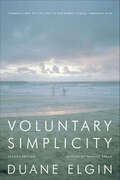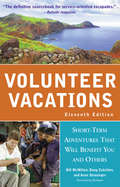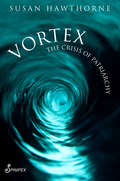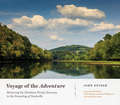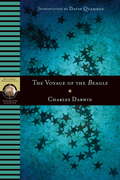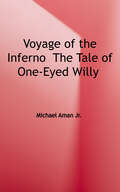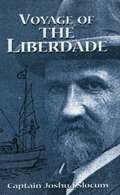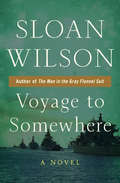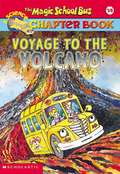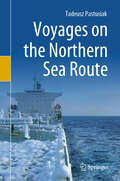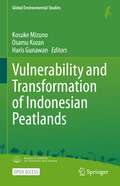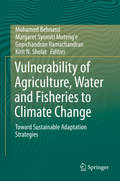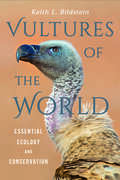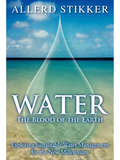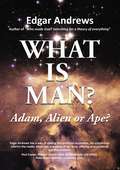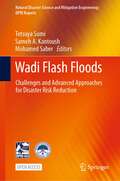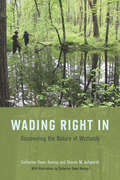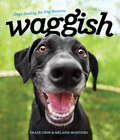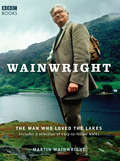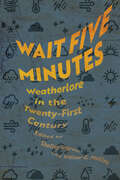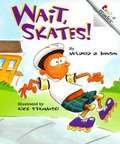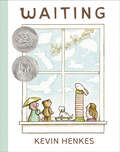- Table View
- List View
Voluntary Simplicity Second: Toward a Way of Life That Is Outwardly Simple, Inwardly Rich
by Duane ElginWhen Voluntary Simplicity was first published in 1981, it quickly became recognized as a powerful and visionary work in the emerging dialogue over sustainable ways of living. Nearly three decades later, as the planet’s environmental stresses become more urgent than ever, Duane Elgin has revised and updated his revolutionary book.Voluntary Simplicity is not about living in poverty; it is about living with balance. This book illuminates the pattern of changes that an increasing number of people around the world are making in their everyday lives—adjustments in day-to-day living that are an active, positive response to the complex dilemmas of our time. By embracing a lifeway of voluntary simplicity—characterized by ecological awareness, frugal consumption, and personal growth—people can change their lives. And in the process, they have the power to change the world.
Volunteer Vacations: Short-Term Adventures That Will Benefit You and Others
by Bill Mcmillon Doug Cutchins Anne Geissinger Ed AsnerFor the increasing number of people looking for ways to make a difference while on vacation, this fully updated edition is filled with in-depth information to get them ready for their adventure, including contacts, locations, costs, dates, project details, and profiles of 150 select organizations running thousands of programs in the United States and around the world. Including new details about long-term projects and organizations specifically tailored for families, seniors, and the disabled, this definitive sourcebook provides a wealth of opportunities for anyone interested in taking a truly meaningful vacation and provides new anecdotes about all kinds of jobs and the positive impact they had on volunteers' lives.
Vortex: The Crisis of Patriarchy
by Susan HawthorneDo we want to live in a world without birdsong? The pesticides, the coal mines, the clear-felling forestry industry, the industrial farmers are destroying the earth with their insistence on profit. But what point is profit on a dead and silent planet?In this enlightening yet devastating book, Susan Hawthorne writes with clarity and incisiveness on how patriarchy is wreaking destruction on the planet and on communities. The twin mantras of globalisation and growth expounded by the neoliberalism that has hijacked the planet are revealed in all their shabby deception. Backed by meticulous research, the author shows how so-called advances in technology are, like a Trojan horse, used to mask sinister political agendas that sacrifice the common good for the shallow profiteering of corporations and mega-rich individuals.The biotechnologists see the lure of cure, rising share prices and profits.She details how women, lesbians, people with disabilities, Indigenous peoples, the poor, refugees and the very earth itself are being damaged by the crisis of patriarchy that is sucking everyone into its vortex. Importantly, this precise and insightful volume also shows what is needed to get ourselves out of this spiral of destruction: a radical feminist approach with compassion and empathy at its core.Shame is an emotion of the powerless because they cannot change the rules.The book shows a way out of the vortex: it is now up to the collective imagination and action of people everywhere to take up the challenges Susan Hawthorne shows are needed. This is a vital book for a world in crisis and should be read by everyone who cares about our future.
Voyage of the Adventure: Retracing the Donelson Party's Journey to the Founding of Nashville
by John GuiderIn the harsh winter of 1779, as the leader of a flotilla of settlers, John Donelson loaded his family and thirty slaves into a forty-foot flatboat at the present site of Kingsport, Tennessee. Their journey into the wilderness led to the founding of a settlement now known as Nashville—over one thousand river miles away. In the fall of 2016, photographer John Guider retraced the Donelson party's journey in his hand-built fourteen-and-a-half-foot motorless rowing sailboat (named Adventure II after Donelson's boat) while making a visual documentation of the river as it currently exists 240 years later. This photo book contains more than 120 striking images from the course of the journey, allowing the reader to see how much has changed and how much has remained untouched in the two and a half centuries since Donelson first took to the water. Equally significant, the essays include long-ignored contemporary histories of both the Cherokee whom Donelson encountered and the slaves he brought with him, some of whom did not survive the journey. From his platform just a few feet above the waterline, Guider, a professional photographer, created images of the thousand-mile trip along three of Tennessee's most notable rivers.
Voyage of the Beagle
by Charles Darwin David QuammenCharles Darwin's theory of evolution and natural selection has been debated and disparaged over time, but there is no dispute that he is responsible for some of the most remarkable and groundbreaking scientific findings in history. His five-year trip as a naturalist on the H.M.S. Beagle took him on a journey to such exotic locales as Chile, Argentina, and the Galapagos Islands. Darwin wrote the details of this expedition, including his thoughts about the people on the ship and of course, his observations of the flora and fauna, in his journal, published as Voyage of the Beagle. It is here that his original interpretations of the Galapagos ecosystem and the impact of nature and selection are first revealed.
Voyage of the Inferno: The Tale of One-Eyed Willy: A Prequal to The Goonies
by C. Michael Aman Jr.This book embarks on the life of an outlaw after being wrongfully accused of a crime he did not commit. Although raised in the Catholic Christian faith, he is plunged into a world of crime, murder, war and thievery. Even when he rises to be the commander of a pirate vessel, he still struggles to maintain his humanity. This is the tale of One-Eyed Willy and his enriching piratical endeavors in the first half of the 17th century.
Voyage of the Liberdade
by Joshua SlocumIn 1890, the author became the first person to circumnavigate the globe alone. This is the account of one of his lesser-known but no less remarkable sea journeys. From the Publisher: Great 19th-century mariner's thrilling, account of the wreck of his ship off the coast of South America, the 35-foot brave little craft he built from the wreckage, and its remarkable, danger-fraught voyage home. A 19th-century maritime classic brimming with courage, ingenuity, and daring. Easy-to-read and fast-paced.
Voyage to Somewhere: A Novel
by Sloan WilsonFrom the bestselling author of The Man in the Gray Flannel Suit, a World War II novel that is as thrilling as it is true to life Hoping to draw a nice, lengthy shore duty after two years at sea, Lieutenant Barton is instead told that he is being sent right back out, this time as captain of a supply ship sailing from California to New Guinea and stopping at every small island in between. Homesick for his wife, he has no choice but to accept the assignment and a crew of twenty-six landlubbers whose last names all begin with W. Their first load of cargo? Pineapples destined for Hawaii. Life aboard the one-hundred-eighty-foot SV-126 is never dull. When Barton isn&’t battling gale-force winds and monstrous waves, he is coping with seasick sailors and budding rivalries that threaten to turn mutinous. Hanging over the ship like a storm cloud is the knowledge that the world is at war and the enemy is never far away. Whether Lieutenant Barton and his crew are fighting torpedoes and typhoons or writing letters to loved ones, Voyage to Somewhere offers a unique and page-turning perspective on what the Second World War was really like.
Voyage to the Volcano (The Magic School Bus Ser. #Vol. 15)
by Judith Stamper John SpeirsGet ready for some serious science fun when the Friz takes the kids on an explosive journey into the heart of a volcano! Hi, I'm Dorothy Ann, one of the kids in Ms. Frizzle's class. When we started learning about volcanoes, I thought we'd just be studying them in books -- but Ms. Frizzle had other ideas. She took us all the way to Hawaii, where we waded through lava and saw a real volcano blow its top. We had a great time -- even though the trip was sometimes almost too hot to handle! One thing's for sure: This was one explosive adventure that none of us will ever forget! Lexile Measure: 680L
Voyages on the Northern Sea Route
by Tadeusz PastusiakThis book explains vessels’ ability to overcome ice on the Northern Sea Route, as well as the criteria of safe speed and maneuvering of vessels on ice. It provides a successful long-term forecast of ice navigation and reveals the dangers of sailing on the Northern Sea Route, It includes tips on how to plan and schedule voyages in the Russian Arctic. The book develops a set of suggested routes for the period of opening and closing of the transit ice-free zone through the NSR based on the last eleven navigation seasons. It presents a method for determining the date for beginning a voyage of a vessel without ice strengthening through the NSR. It also develops a model of initial (long-term) and operational decision-making support system for vessel voyage planning and scheduling. The main audience for the book are officers at operational and management level of competency, people planning voyages on the Northern Sea Route in the office of ship operator and in chartering department or consulting company, and participants of Ice Navigator IMO Model Courses at basic and advanced level of competency.
Vulnerability and Transformation of Indonesian Peatlands (Global Environmental Studies)
by Kosuke Mizuno Osamu Kozan Haris GunawanThis open access book deals with restoring degraded peatlands to help mitigate global warming, to which SDG 15 and SDG 13 are directly related. The book analyzes peatland degradation and restoration of the Indonesian peatland ecosystem through the integrated lens of resilience, vulnerability, adaptation, and transformation. It sheds light on what constitutes "resilience" of the peat swamp forest, digs deeper into local knowledge in developing the studies on institutions, governance, and ecological conditions that support the resilience of the peat swamp forest to elaborate on the idea of transformation in today's degraded peatlands. While peat swamp forests may be resilient, they remain highly vulnerable. The book analyzes restoration efforts through rewetting, revegetation, and rehabilitation of the local livelihoods with the concepts of adaptation and transformation. The integrated analysis covers fieldwork of more than a decade and various aspects such as agrarian and social changes, biological changes (birds, mammals, and termites), carbon emission, water control, timber use, revegetation efforts, and the Indonesia Sustainable Palm Oil (ISPO) program implementation. It also employs the ideas of vulnerability, resilience, adaptability, and transformation based on expanded studies on peatlands and observations of and participation in multiple efforts to prevent fires and restore the degraded peatland by researchers, the government, non-government organizations (NGOs), private companies, and last but not least, the local people. The discussion includes the period of pre-degradation and several efforts at peatland restoration for a better understanding and analysis of the long-term peatland dynamics.
Vulnerability of Agriculture, Water and Fisheries to Climate Change
by Mohamed Behnassi Margaret Syomiti Muteng'E Gopichandran Ramachandran Kirit N. ShelatHuman activity is changing the global environment at an unprecedented rate while humanity faces a range of complex and interrelated challenges to local, regional and global development, human security and politics. Food security ranks high on the science, policy and development agendas. However, most research linking global change and food systems examines the impact of climate change on agricultural production, or the impact of agriculture on land use, pollution and biodiversity, overlooking interactions with other aspects of the food system - such as food processing, packaging, transportation and consumption and employment derived from these activities. This book demonstrates that new threats to food security which arise from environmental change require more than simply a focus on agricultural practices - what is needed is an integrated food system approach. The authors point out that the process of adapting food systems to global environmental change is not simply a search for technological solutions to increase agricultural yields. Tradeoffs across multiple scales among food system outcomes are a prevalent feature of globalized food systems. Within food systems, there are key underexplored areas that are both sensitive to environmental change and crucial to understanding its implications for food security and adaptation strategies. The authors assert that technical prescriptions alone will not efficiently manage the food security challenge. This book is their contribution to a new paradigm, which addresses food systems holistically by engaging researchers in multiple disciplines to understand the causes and drivers of vulnerability.
Vultures (Nature's Children)
by Tim HarrisWhere do vultures live? What do vultures eat? How big are vultures? Find out the answers to these questions and learn all about vultures physical characteristics, behavior, and habitats.
Vultures of the World: Essential Ecology and Conservation
by Keith L. BildsteinIn Vultures of the World, Keith L. Bildstein provides an engaging look at vultures and condors, seeking to help us understand these widely recognized but underappreciated birds. Bildstein's latest work is an inspirational and long overdue blend of all things vulture. Based on decades of personal experience, dozens of case studies, and numerous up-to-date examples of cutting-edge science, this book introduces readers to the essential nature of vultures and condors. Not only do these most proficient of all vertebrate scavengers clean up natural and man-made organic waste but they also recycle ecologically essential elements back into both wild and human landscapes, allowing our ecosystems to function successfully across generations of organisms. With distributions ranging over more than three-quarters of all land on five continents, the world's twenty-three species of scavenging birds of prey offer an outstanding example of biological diversity writ large. Included in the world's species fold are its most abundant large raptors—several of its longest lived birds and the most massive of all soaring birds. With a fossil record dating back more than fifty million years, vultures and condors possess numerous adaptions that characteristically serve them well but at times also make them particularly vulnerable to human actions. Vultures of the World is a truly global treatment of vultures, offering a roadmap of how best to protect these birds and their important ecology.
WATER: Exploring Sustainable Water Management for the New Millennium
by Allerd Stikker"Allerd Stikker has always reminded me of Alexis de Tocqueville, who would have chosen to study the problem surrounding water rather than the American democracy. He has the same insatiable curiosity, the same energy, same passion, same ease in mixing analysis with intuition, the capacity to draw together different cultures, the same capacity to listen and to dialogue with those who reason from different starting blocks. "Water, the Blood of the Earth is the outcome of reflection and action of a cosmopolitan who has remained loyal to his native land, mixing some European thinking of the Age of Enlightenment with some futuristic viewpoints." -Charles Louis de Maudhuy, advisor to the chairman, Veolia Water "Lack of access to clean and sufficient water in many parts of the world, especially in Asia and Africa, will be a major issue in the coming decades. "This book presents an overall view on the diversity of problems and solutions, based on the author's involvement in water-related projects. Over the course of the years I have followed some of these projects with interest; they inspire us to take concrete actions." -Antony Burgmans, former chairman, Unilever "In this book Allerd describes his convincing views on desalination solutions for local and urban clean water shortages as well as his deeply felt findings on the spiritual meanings of water, all assembled on a 20 years' journey on which I was lucky to travel along." -Leonor Lindner
WHAT IS MAN?: Adam, Alien or Ape?
by Edgar AndrewsIn 1906, American humorist Mark Twain published a sixty-page essay entitled “What is man?” Consisting of an interminable dialogue between a senior citizen (who believes that man is just a machine) and a young man (who believes nothing in particular but is open to persuasion), it wasn’t one of his finest books. But at least he tried. Authors since then seem to have avoided the subject like the plague, often tackling the respective roles of men and women in society but seldom asking deeper questions about what it means to be human. When the psalmist asked, “What is man?” (Psalm 8 v.4) he was, I think, seeking an altogether more profound answer.Avoidance of the subject is all the more strange because there has never been a time like our own when curiosity about human origins and destiny has been greater, or the answers on offer more hotly disputed. It’s a safe bet that any attempt to give the “big picture” on the origin, nature and specialness of mankind will be contentious —which might explain why writers have generally fought shy of it. Yet at heart it is the question most of us really do want answered, because the answer defines that precious thing we call our identity, both personally and as a race.The Psalmist did, of course, offer his own answer three millennia ago. Man, he claimed, was created by God for a clearly defined purpose — to exercise dominion over planet earth and (by implication) to ultimately share something of the glory of the divine nature. The rest, as they say, is history, but it’s not a happy tale. As Mark Twain says in another essay; “I can’t help being disappointed with Adam and Eve”. Not surprisingly, then, a large proportion of humanity today are looking for alternative solutions, accepting the challenge of the Psalmist’s question without embracing the optimism of his answer.In this book we are going to consider the alternative solutions on offer by considering what it means to be human against the backgrounds of cosmology (man’s place in the universe), biology (man’s place in the animal kingdom), and psychology (man’s consciousness and mind). Finally, we return to the biblical context, arguing that the Psalmist got it right after all.Don’t let the science-sounding stuff put you off. Like its popular prequel, “Who made God? Searching for a theory of everything”, this book is written with a light touch in a reader-friendly and often humorous style. It is intended specifically for the non-expert, with homely verbal illustrations designed to explain and unpack the technicalities for the lay-person. As Dr. Paul Copan (Pledger Family Chair of Philosophy and Ethics, Palm Beach Atlantic University) says, "Edgar Andrews has a way of making the profound accessible. His scholarship informs the reader about key questions of our time, offering wise guidance and illumination."
WTF, Evolution?!: A Theory of Unintelligible Design
by Mara GrunbaumWe all have our off days. Why should Evolution be any different? Maybe Evolution got carried away with an idea that was just a little too crazy—like having the Regal Horned Lizard defend itself by shooting three-foot streams of blood from its eyes. Or maybe Evolution ran out of steam (Memo to Evolution: The Irrawaddy Dolphin looks like a prototype that should have been left on the drawing board). Or maybe Evolution was feeling cheeky—a fish with hands? Joke’s on you, Red Handfish! Or maybe Evolution simply goofed up: How else to explain the overgrown teeth of the babirusas that curl backward over their face? Oops. Mara Grunbaum is a very smart, very funny science writer who celebrates the best—or, really, the worst—of Evolution’s blunders. Here are more than 100 outlandish mammals, reptiles, insects, fish, birds, and other creatures whose very existence leaves us shaking our heads and muttering WTF?! Ms. Grunbaum’s especially brilliant stroke is to personify Evolution as a well-meaning but somewhat oblivious experimenter whose conversations with a skeptical narrator are hilarious. For almost 4 billion years, Evolution has produced a nonstop parade of inflatable noses, bizarre genitalia, and seriously awkward necks. What a comedian!
Wacky Weather for Walter (Read and Roll)
by Amy ParadisWalter is driving to his sister's house across town. With plenty of Wacky Weather for Walter in store, will he make it there in one piece?
Wadi Flash Floods: Challenges and Advanced Approaches for Disaster Risk Reduction (Natural Disaster Science and Mitigation Engineering: DPRI reports)
by Tetsuya Sumi Sameh A. Kantoush Mohamed SaberThis open access book brings together research studies, developments, and application-related flash flood topics on wadi systems in arid regions. The major merit of this comprehensive book is its focus on research and technical papers as well as case study applications in different regions worldwide that cover many topics and answer several scientific questions. The book chapters comprehensively and significantly highlight different scientific research disciplines related to wadi flash floods, including climatology, hydrological models, new monitoring techniques, remote sensing techniques, field investigations, international collaboration projects, risk assessment and mitigation, sedimentation and sediment transport, and groundwater quality and quantity assessment and management. In this book, the contributing authors (engineers, researchers, and professionals) introduce their recent scientific findings to develop suitable, applicable, and innovative tools for forecasting, mitigation, and water management as well as society development under seven main research themes as follows: Part 1. Wadi Flash Flood Challenges and Strategies Part 2. Hydrometeorology and Climate Changes Part 3. Rainfall–Runoff Modeling and Approaches Part 4. Disaster Risk Reduction and Mitigation Part 5. Reservoir Sedimentation and Sediment Yield Part 6. Groundwater Management Part 7. Application and Case Studies The book includes selected high-quality papers from five series of the International Symposium on Flash Floods in Wadi Systems (ISFF) that were held in 2015, 2016, 2017, 2018, and 2020 in Japan, Egypt, Oman, Morocco, and Japan, respectively. These collections of chapters could provide valuable guidance and scientific content not only for academics, researchers, and students but also for decision-makers in the MENA region and worldwide.
Wading Right In: Discovering the Nature of Wetlands
by Catherine Owen Koning Sharon M. AshworthWhere can you find mosses that change landscapes, salamanders with algae in their skin, and carnivorous plants containing whole ecosystems in their furled leaves? Where can you find swamp-trompers, wildlife watchers, marsh managers, and mud-mad scientists? In wetlands, those complex habitats that play such vital ecological roles. In Wading Right In, Catherine Owen Koning and Sharon M. Ashworth take us on a journey into wetlands through stories from the people who wade in the muck. Traveling alongside scientists, explorers, and kids with waders and nets, the authors uncover the inextricably entwined relationships between the water flows, natural chemistry, soils, flora, and fauna of our floodplain forests, fens, bogs, marshes, and mires. Tales of mighty efforts to protect rare orchids, restore salt marshes, and preserve sedge meadows become portals through which we visit major wetland types and discover their secrets, while also learning critical ecological lessons. The United States still loses wetlands at a rate of 13,800 acres per year. Such loss diminishes the water quality of our rivers and lakes, depletes our capacity for flood control, reduces our ability to mitigate climate change, and further impoverishes our biodiversity. Koning and Ashworth’s stories captivate the imagination and inspire the emotional and intellectual connections we need to commit to protecting these magical and mysterious places.
Waggish: Dogs Smiling For Dog Reasons
by Grace Chon Melanie MonteiroTo be "waggish" is to be playful and mischievous—the very definition of these adorable dogs and the things they (might) think about us There's no mistaking a happy dog. The wagging tail, the eager eyes, the smile that's impossible to fake. A happy dog radiates pure joy. Yet the mystery remains: What's really going on behind those waggish grins? Are our dogs laughing with us? At us? Are they operating at a higher stage of enlightenment . . . or just buttering us up before we discover the tiny, torn remnants of burrito wrapper suspiciously dotting the hallway? In Waggish, the infinite expressions of happy dogs are captured in an amazing series of photographs by renowned animal photographer Grace Chon, whose images have made her the go-to pet photographer of Hollywood’s top celebrities. As for what these dogs are really thinking, writer Melanie Monteiro expertly channels their innermost thoughts, pairing each photo with a caption such as, “If loving tennis balls is wrong, I don’t want to be right” and “You know, we’ll both get outside a lot quicker if you just forget the pants.” Waggish is the perfect gift for every dog lover.
Wainwright: The Man Who Loved the Lakes
by Martin WainwrightWainwright: The Man Who Loved the Lakes is a celebration of the British landscape, and it tells the remarkable story of Alfred Wainwright who in 1952 decided to hand draw a series of guides to the fells of Lakeland. For the next 13 years he spent every weekend walking, and every weekday evening drawing and writing - completing one page per night. The result was Wainwright's Pictorial Guides to the Lakeland Fells. Although initially self published they have now sold over a million copies and are still popular and much loved today. He went on to present a series of TV shows on the BBC about walking in the Lake District that made him even better known. He was an unlikely celebrity, he preferred his own company and thought walking in the countryside should be a solitary rather than group pursuit. Wainwright: The Man Who Loved the Lakes introduces him to a new generation of lovers of the countryside, features some of Wainwright's favourite walks and is lavishly illustrated, including stunning aerial shots of the Lake District.
Wait Five Minutes: Weatherlore in the Twenty-First Century
by Shelley Ingram, Willow G. MullinsContributions by Emma Frances Bloomfield, Sheila Bock, Kristen Bradley, Hannah Chapple, James Deutsch, Máirt Hanley, Christine Hoffmann, Kate Parker Horigan, Shelley Ingram, John Laudun, Jordan Lovejoy, Lena Marander-Eklund, Jennifer Morrison, Willow G. Mullins, Anne Pryor, Todd Richardson, and Claire Schmidt The weather governs our lives. It fills gaps in conversations, determines our dress, and influences our architecture. No matter how much our lives may have moved indoors, no matter how much we may rely on technology, we still monitor the weather. Wait Five Minutes: Weatherlore in the Twenty-First Century draws from folkloric, literary, and scientific theory to offer up new ways of thinking about this most ancient of phenomena.Weatherlore is a concept that describes the folk beliefs and traditions about the weather that are passed down casually among groups of people. Weatherlore can be predictive, such as the belief that more black than brown fuzz on a woolly bear caterpillar signals a harsh winter. It can be the familiar commentary that eases daily social interactions, such as asking, “Is it hot (or cold) enough for you?” Other times, it is simply ubiquitous: “If you don’t like the weather, wait five minutes and it will change.” From detailing personal experiences at picnics and suburban lawns to critically analyzing storm stories, novels, and flood legends, contributors offer engaging multidisciplinary perspectives on weatherlore. As we move further into the twenty-first century, an increasing awareness of climate change and its impacts on daily life calls for a folkloristic reckoning with the weather and a rising need to examine vernacular understandings of weather and climate. Weatherlore helps us understand and shape global political conversations about climate change and biopolitics at the same time that it influences individual, group, and regional lives and identities. We use weather, and thus its folklore, to make meaning of ourselves, our groups, and, quite literally, our world.
Wait, Skates! (Fountas & Pinnell LLI Blue #Level E)
by Mildred Johnson Rick StromoskiA child putting on in-line roller skates for the first time must make them wait until they are ready to go straight.
Waiting
by Kevin HenkesWhat are you waiting for? An owl, a puppy, a bear, a rabbit, and a pig wait for marvelous things to happen in this irresistible and resonant picture book by the New York Times–bestselling and Caldecott Medalist Kevin Henkes.Five friends sit happily on a windowsill, waiting for something amazing to happen. The owl is waiting for the moon. The pig is waiting for the rain. The bear is waiting for the wind. The puppy is waiting for the snow. And the rabbit is just looking out the window because he likes to wait! What will happen? Will patience win in the end? Or someday will the friends stop waiting and do something unexpected?Waiting is a big part of childhood—waiting in line, waiting to grow up, waiting for something special to happen—but in this book, a child sets the stage and pulls the strings. Timeless, beautiful, and deeply heartfelt, this picture book about imaginative play, the seasons, friendship, and surprises is a Caldecott Honor and Geisel Honor Book.Share Waiting alongside Mo Willems's Waiting Is Not Easy at home or in a classroom—these books about waiting for kids will be enjoyed as picture book stories and also allow kids to explore their emotions about that ultimate frustration: waiting.“The short sentences of the text flow with the precision one would expect from a master picture-book creator like Henkes. Little ones, to whom each experience is new, will know what it’s like to dream and wait.”—ALA Booklist
